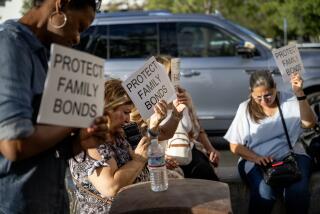The Family Man
- Share via
One thing you can say for Grandfather Skousen--he was a good family man. Some might say too good.
With him, there was none of this divorce with its custody disputes, child support battles, Disneyland Dad sorts of weekends. When another woman came along, why, he married her too.
Though my grandfather’s practice of polygamy was judged by some to be immoral--and was certainly illegal--as of last count, 775 people, including myself, have consequently appeared on this Earth.
I saw a few hundred of them--most for the first time--last month at my first Skousen family reunion in Heber, Ariz.
I knew pieces of this unusual family lore, since the Skousens, like many Mormon families, keep thorough genealogical records. Indeed, an inch-thick bound family book, “Skousens in America,” includes a chart that shows exactly how present-day Skousens are descended from Adam and Eve. Parts of the lineage are indicated by dots, though it’s unclear whether the reason is honesty or lack of space.
Anyway, it appears from the stories in the book that Jim Skousen grew up thinking families came with two wives and one husband. His father, a Dane converted by Mormon missionaries in 1862, promptly married his common-law wife and immigrated to the United States where she, apparently caught up in the passion of religious pioneering, insisted he also marry their disabled nanny. They had 17 children. A grainy picture in the book shows Yuma Territorial Prison where he did time for this arrangement. In the picture he is baby-sitting the warden’s children.
By the time Grandfather Skousen came of age, polygamy was fading; his family and others had fled the U.S. for Mexico. When and where he got “the call” to plural marriage from church authorities is a matter of some dispute. Nevertheless, five years after marrying 17-year-old Ida, the daughter of polygamists, he married Emma, a 24-year-old schoolteacher.
The three lived side by side, squeezing a living from the land, spending their lives in Mexico and, later, Chandler, Ariz. They had 23 children. I had met four or five.
There’s something about American democracy, as the Frenchman Alexis de Tocqueville observed in the 19th century, that separates people from their ancestors. Upwardly mobile, my parents had long since uprooted, moved farther west, urbanized and secularized. I grew up tradition-free, another California tumbleweed, reading about my ancestors in a book.
There must be more to their stories, I thought. As other descendants of Mormons were retracing the cross-country trek of their pioneer ancestors, I was hoping the summer reunion could enlighten me on what happened after that.
First, I found that by now, there are so many Skousen descendants that each branch of the family had been assigned a different colored T-shirt. Some had come up with catchy names like “Grant’s Group.” “Basil’s Bunch” had a logo, a cow, signifying their patriarch’s profession in the dairy business. One branch, whose parents had just celebrated their 50th anniversary, had maroon shirts emblazoned with family tree charts, “Know Who You Are,” and “The First 50 Years of Eternity.” Believers, mostly, come to these reunions.
We probably looked like any other big family. There were octogenarians and toddlers. The svelte and the obese. Bleached-haired boys in trendy T-shirts, pretty girls in shorts. People who had been widowed, divorced or disabled by tragic car accidents. Enthusiasts who stayed for every planned event at the campground and the church, others who made an appearance and retreated to the motel down the road.
Competition and humor were common, from the tug of war between genders to age-group races to a family quiz: “How did Mur die?” (In WWII.) “Why did Jim leave Mexico?” (The Mexican Revolution.) “Who is the most stubborn Skousen?” (The one you’re married to.)
Polygamy wasn’t on the quiz. Some just don’t think about it, and others are still sensitive. People said that at a recent funeral, there was no mention of any of the deceased’s half brothers or sisters.
Others of my parents’ generation had plenty of stories about their Skousen parents, mostly conflicting. Some said their father was home only every other night and every other morning. Some thought it might have been every other week.
Some remember the two wives getting along fine. Some say they argued over things, like heirlooms, or their one washing machine that had to be moved from house to house on laundry day. Some say they fought over their man.
Some said the law left them alone. Others recalled that if ever disgruntled town folk called the sheriff, a kindly neighbor would give a ring and Grandfather Skousen would go hide in the ditch. Some remembered school honors being withheld because of their parents, others said the community had to accept them because they were acceptable--good students, great athletes, handsome and otherwise law-abiding.
They mostly remembered their father as kind and fair, rarely spanking anyone and disciplining them by singing original lyrics to church hymns. Some insisted that their upbringing taught them mutual reliance, independence and even, oddly enough, family values. Others said what I had expected: In a climate of male privilege, the hardships were greater on the girls.
Grandfather Skousen died in 1957 at age 84.
In his last days, he sounded the first note of regret. Perhaps he appreciated the toll of polygamy on his wives and children. Perhaps his faith faltered. Perhaps he wished he had paid more attention to the world that changed around him, to the country that had found limits to its religious tolerance.
Perhaps he was exhausted. In pictures he looks like Mark Twain after a long New Year’s Eve party.
In any case, the story goes that he told his sons that he sometimes wondered if he had done the wrong thing.
Recent history has shown many men have done much worse by their families. He didn’t run away. He didn’t choose or favor one family over the other. He made his beds--and lay in them both.


